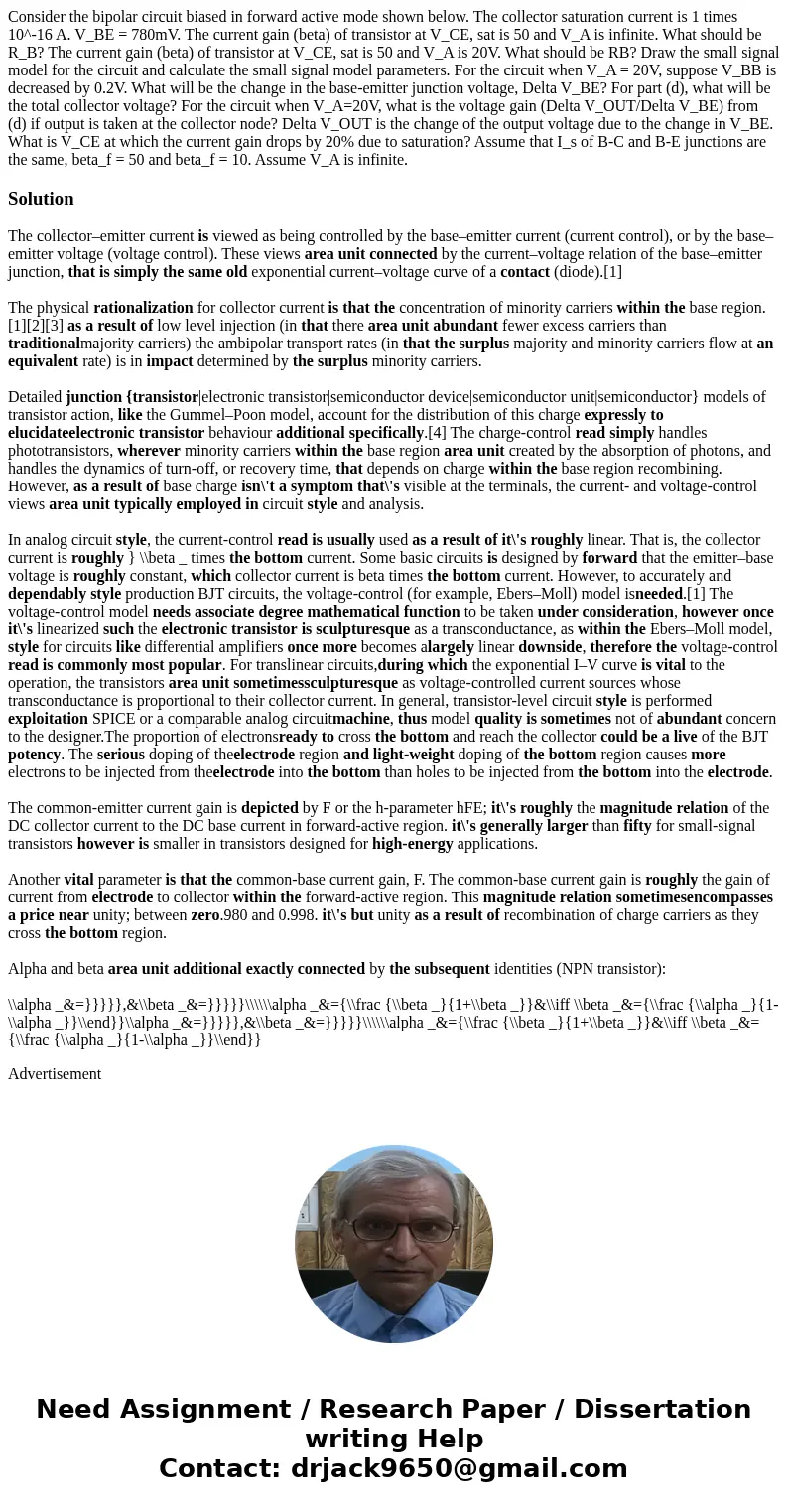Consider the bipolar circuit biased in forward active mode s
Solution
The collector–emitter current is viewed as being controlled by the base–emitter current (current control), or by the base–emitter voltage (voltage control). These views area unit connected by the current–voltage relation of the base–emitter junction, that is simply the same old exponential current–voltage curve of a contact (diode).[1]
The physical rationalization for collector current is that the concentration of minority carriers within the base region.[1][2][3] as a result of low level injection (in that there area unit abundant fewer excess carriers than traditionalmajority carriers) the ambipolar transport rates (in that the surplus majority and minority carriers flow at an equivalent rate) is in impact determined by the surplus minority carriers.
Detailed junction {transistor|electronic transistor|semiconductor device|semiconductor unit|semiconductor} models of transistor action, like the Gummel–Poon model, account for the distribution of this charge expressly to elucidateelectronic transistor behaviour additional specifically.[4] The charge-control read simply handles phototransistors, wherever minority carriers within the base region area unit created by the absorption of photons, and handles the dynamics of turn-off, or recovery time, that depends on charge within the base region recombining. However, as a result of base charge isn\'t a symptom that\'s visible at the terminals, the current- and voltage-control views area unit typically employed in circuit style and analysis.
In analog circuit style, the current-control read is usually used as a result of it\'s roughly linear. That is, the collector current is roughly } \\beta _ times the bottom current. Some basic circuits is designed by forward that the emitter–base voltage is roughly constant, which collector current is beta times the bottom current. However, to accurately and dependably style production BJT circuits, the voltage-control (for example, Ebers–Moll) model isneeded.[1] The voltage-control model needs associate degree mathematical function to be taken under consideration, however once it\'s linearized such the electronic transistor is sculpturesque as a transconductance, as within the Ebers–Moll model, style for circuits like differential amplifiers once more becomes alargely linear downside, therefore the voltage-control read is commonly most popular. For translinear circuits,during which the exponential I–V curve is vital to the operation, the transistors area unit sometimessculpturesque as voltage-controlled current sources whose transconductance is proportional to their collector current. In general, transistor-level circuit style is performed exploitation SPICE or a comparable analog circuitmachine, thus model quality is sometimes not of abundant concern to the designer.The proportion of electronsready to cross the bottom and reach the collector could be a live of the BJT potency. The serious doping of theelectrode region and light-weight doping of the bottom region causes more electrons to be injected from theelectrode into the bottom than holes to be injected from the bottom into the electrode.
The common-emitter current gain is depicted by F or the h-parameter hFE; it\'s roughly the magnitude relation of the DC collector current to the DC base current in forward-active region. it\'s generally larger than fifty for small-signal transistors however is smaller in transistors designed for high-energy applications.
Another vital parameter is that the common-base current gain, F. The common-base current gain is roughly the gain of current from electrode to collector within the forward-active region. This magnitude relation sometimesencompasses a price near unity; between zero.980 and 0.998. it\'s but unity as a result of recombination of charge carriers as they cross the bottom region.
Alpha and beta area unit additional exactly connected by the subsequent identities (NPN transistor):
\\alpha _&=}}}}},&\\beta _&=}}}}}\\\\\\alpha _&={\\frac {\\beta _}{1+\\beta _}}&\\iff \\beta _&={\\frac {\\alpha _}{1-\\alpha _}}\\end}}\\alpha _&=}}}}},&\\beta _&=}}}}}\\\\\\alpha _&={\\frac {\\beta _}{1+\\beta _}}&\\iff \\beta _&={\\frac {\\alpha _}{1-\\alpha _}}\\end}}
Advertisement

 Homework Sourse
Homework Sourse